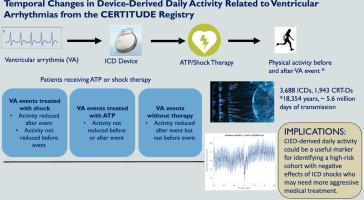Temporal changes in device-derived daily activity related to ventricular arrhythmias from the CERTITUDE registry
IF 2.5
Q2 CARDIAC & CARDIOVASCULAR SYSTEMS
引用次数: 0
Abstract
Background
There have been limited data examining the temporal relationship between device-derived daily activity and ventricular arrhythmias (VAs).
Objective
We aimed to assess whether activity predicted VAs or VAs predicted changes in activity.
Methods
The CERTITUDE registry includes over 55,000 implanted devices active on Home Monitoring. Daily data on activity are captured by a 1-axis accelerometer. Temporal changes in activity during treated VAs were analyzed using the first event and 7-day activity windows (baseline, pre-event, and postevent). Baseline period was defined as 31 to 38 days prior to VA. VAs were categorized by heart rate (≤200 beats/min, >200 beats/min) and treatment (shock or antitachycardia pacing). Differences were assessed using the binomial proportion test and case-crossover analysis.
Results
A total of 5631 devices (3688 implantable cardioverter-defibrillators, 1943 cardiac resynchronization therapy defibrillators) were analyzed with a cumulative follow-up duration of 18,354 years (5.6 million days). Patients with VA events >200 beats/min with shock (n = 593) had a significant decline in activity post-VA with a median –8.7% reduction (interquartile range –24.6% to 7.3%, P < 0.001). However, there was no reduction in activity before VA events >200 beats/min (P = .690) or before or after VA events >200 beats/min with antitachycardia pacing. However, VA events ≤200 beats/min with shock had reductions in activity following the event (–5.8%, interquartile range –29.5% to 12.3%, P = .003). Case-crossover analyses confirmed lower activity rates following for VA events >200 beats/min with shock.
Conclusion
In the CERTITUDE registry, we have shown a temporal decline in device-derived activity following VA events >200 beats/min and for VA events <200 beats/min treated with a shock, but we did not find changes in activity preceding a shock event.

CERTITUDE 登记册中与室性心律失常有关的设备衍生日常活动的时间变化
背景研究设备得出的日常活动与室性心律失常(VAs)之间时间关系的数据有限。目标我们旨在评估活动是否能预测 VAs 或 VAs 是否能预测活动的变化。每日活动数据由单轴加速度计采集。使用第一个事件和 7 天活动窗口(基线、事件前和事件后)分析了治疗 VAs 期间活动的时间变化。基线期被定义为 VA 前的 31 至 38 天。根据心率(≤200 次/分,>200 次/分)和治疗方法(电击或抗心动过速起搏)对 VAs 进行分类。结果 共分析了 5631 台设备(3688 台植入式心律转复除颤器、1943 台心脏再同步治疗除颤器),累计随访时间为 18354 年(560 万天)。发生 VA 事件>200 次/分并伴有电击的患者(n = 593)在 VA 后活动量显著下降,中位数下降了 -8.7%(四分位间范围为 -24.6% 至 7.3%,P <0.001)。然而,在 VA 事件 >200 次/分之前(P = .690)或使用抗心动过速起搏的 VA 事件 >200 次/分之前或之后,活动量没有减少。然而,≤200 次/分的 VA 事件与休克发生后的活动减少(-5.8%,四分位间范围-29.5% 至 12.3%,P = .003)。结论 在 CERTITUDE 登记中,我们发现在发生 VA 事件 >200 次/分钟后,以及在发生 VA 事件 <200 次/分钟并进行电击后,设备衍生的活动在时间上有所下降,但我们没有发现电击事件前的活动发生了变化。
本文章由计算机程序翻译,如有差异,请以英文原文为准。
求助全文
约1分钟内获得全文
求助全文
来源期刊

Heart Rhythm O2
Cardiology and Cardiovascular Medicine
CiteScore
3.30
自引率
0.00%
发文量
0
审稿时长
52 days
 求助内容:
求助内容: 应助结果提醒方式:
应助结果提醒方式:


